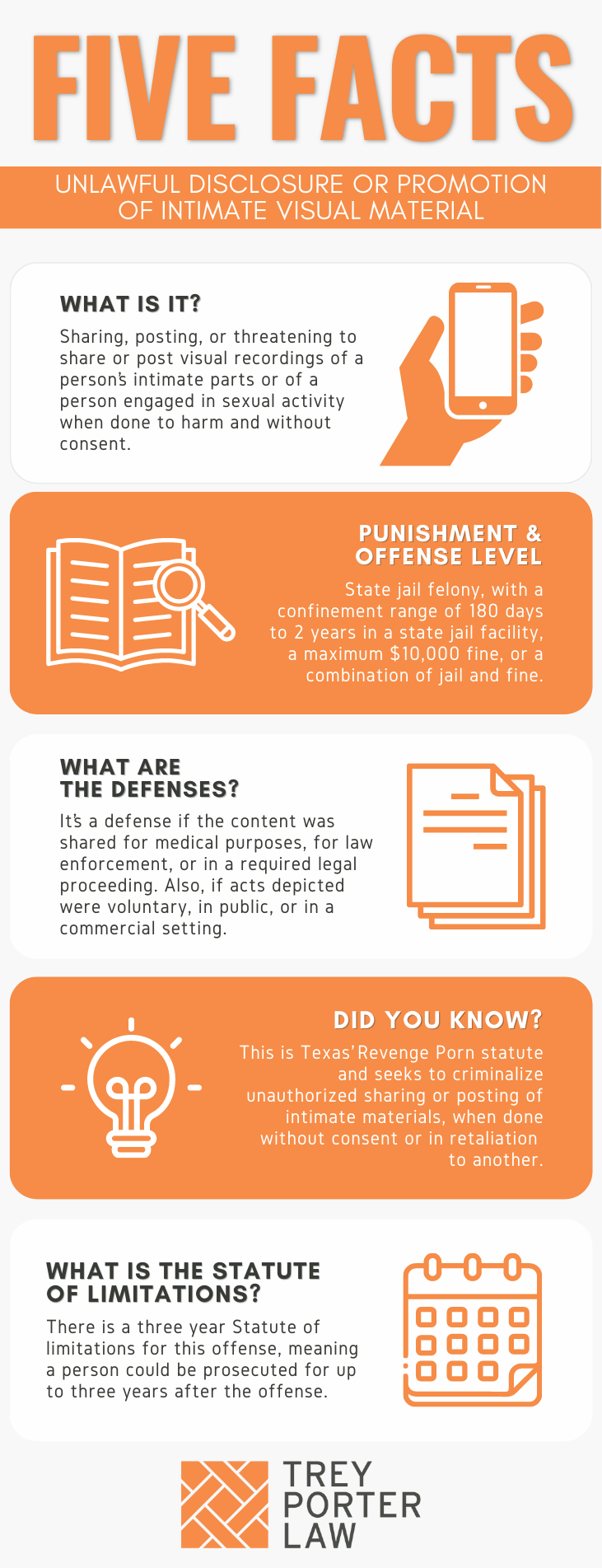WHAT IS UNLAWFUL DISCLOSURE OR PROMOTION OF INTIMATE VISUAL MATERIAL IN TEXAS?
Unlawful disclosure or promotion of intimate visual material is known as the “revenge porn” statute. It prohibits disseminating photographs or videos of a person, obtained with the person’s consent, but with the understanding that the photos or videos would remain private.

WHAT IS THE UNLAWFUL DISCLOSURE OR PROMOTION OF INTIMATE VISUAL MATERIAL LAW IN TEXAS?
Tex. Penal Code § 21.16. UNLAWFUL DISCLOSURE OR PROMOTION OF INTIMATE VISUAL MATERIAL.
(b) A person commits an offense if:
(1) without the effective consent of the depicted person and with the intent to harm that person, the person discloses visual material depicting another person with the person’s intimate parts exposed or engaged in sexual conduct;
(2) at the time of the disclosure, the person knows or has reason to believe that the visual material was obtained by the person or created under circumstances in which the depicted person had a reasonable expectation that the visual material would remain private;
(3) the disclosure of the visual material causes harm to the depicted person; and
(4) the disclosure of the visual material reveals the identity of the depicted person in any manner, including through:
(A) any accompanying or subsequent information or material related to the visual material; or
(B) information or material provided by a third party in response to the disclosure of the visual material.
(c) A person commits an offense if the person intentionally threatens to disclose, without the consent of the depicted person, visual material depicting another person with the person’s intimate parts exposed or engaged in sexual conduct and the actor makes the threat to obtain a benefit:
(1) in return for not making the disclosure; or
(2) in connection with the threatened disclosure.
(d) A person commits an offense if, knowing the character and content of the visual material, the person promotes visual material described by Subsection (b) on an Internet website or other forum for publication that is owned or operated by the person.
(e) It is not a defense to prosecution under this section that the depicted person:
(1) created or consented to the creation of the visual material; or
(2) voluntarily transmitted the visual material to the actor.
(f) It is an affirmative defense to prosecution under Subsection (b) or (d) that:
(1) the disclosure or promotion is made in the course of:
(A) lawful and common practices of law enforcement or medical treatment;
(B) reporting unlawful activity; or
(C) a legal proceeding, if the disclosure or promotion is permitted or required by law;
(2) the disclosure or promotion consists of visual material depicting in a public or commercial setting only a person’s voluntary exposure of:
(A) the person’s intimate parts; or
(B) the person engaging in sexual conduct; or
(3) the actor is an interactive computer service, as defined by 47 U.S.C. Section 230, and the disclosure or promotion consists of visual material provided by another person.
(g) An offense under this section is a state jail felony.
(h) If conduct that constitutes an offense under this section also constitutes an offense under another law, the actor may be prosecuted under this section, the other law, or both.
WHAT IS THE PENALTY CLASS FOR UNLAWFUL DISCLOSURE OR PROMOTION OF INTIMATE VISUAL MATERIAL IN TEXAS?
Unlawful disclosure or promotion of intimate visual material is a state jail felony, punishable by 180 days to two years in a state jail facility. However, if the offense is committed against a public servant, a member of the public servant’s family or household, or property owned or controlled by a public servant, in retaliation for or on account of the public servant’s status, the penalty classification is increased to a third degree felony, punishable by two to ten years in prison. See Tex. Penal Code § 12.501.
WHAT IS THE PUNISHMENT RANGE FOR UNLAWFUL DISCLOSURE OR PROMOTION OF INTIMATE VISUAL MATERIAL IN TEXAS?
The punishment range for unlawfully disclosing or promoting intimate visual material, a state jail felony, is 180 days to two years in a state jail facility, and up to a $10,000 fine. If the punishment range is increased to a third degree felony, the punishment range is two to ten years in prison, and a maximum $10,000 fine.
WHAT ARE THE PENALTIES FOR UNLAWFUL DISCLOSURE OR PROMOTION OF INTIMATE VISUAL MATERIAL IN TEXAS?
A person charged with unlawful disclosure or promotion of intimate visual material may be eligible for probation after a conviction, or deferred adjudication without a conviction, for a period between two and five years, with the possibility of extending supervision for up to ten years. If increased to a third degree felony, the period of probation or deferred adjudication may not exceed ten years.
WHAT ARE THE DEFENSES TO UNLAWFUL DISCLOSURE OR PROMOTION OF INTIMATE VISUAL MATERIAL IN TEXAS?
The statute lists affirmative defenses to unlawfully disclosing or promoting intimate visual material. It is an affirmative defense if:
- law enforcement or medical professionals disclose the visual material for their respective professional purposes, including medical treatment or reporting unlawful activity;
- the person depicted in the visual material voluntarily exposed himself or herself in a public or commercial setting;
- the photos or videos are disseminated on an interactive computer service, which enables access by multiple users to a server, and the disclosure was provided by one of the users.
WHAT IS THE STATUTE OF LIMITATIONS FOR UNLAWFUL DISCLOSURE OR PROMOTION OF INTIMATE VISUAL MATERIAL IN TEXAS?
The limitation period for unlawful disclosure or promotion of intimate visual material, a state jail felony, is three years.
UNLAWFUL DISCLOSURE OR PROMOTION OF INTIMATE VISUAL MATERIAL IN TEXAS
The unlawful disclosure or promotion of intimate visual material, or “revenge porn” statute, is designed to protect sexual privacy, and the identity of individuals depicted in private nude photographs and videos. The person disseminating the intimate visual material must do so with the intent to harm the individual depicted therein, but this element can be logically inferred based on the act of dissemination itself, and the targeted recipients.
TEXAS UNLAWFUL DISCLOSURE OR PROMOTION OF INTIMATE VISUAL MATERIAL COURT CASES
The case law regarding unlawful disclosure or promotion of intimate visual material in Texas shows the constitutional concerns with this statute, and its restriction on a person’s freedom of speech.
- In Ex parte Fairchild-Porche, the defendant sent nude photos showing the victim’s face to the victim’s coworkers. She got the photos of the victim with his consent, but for her eyes only. The defendant argued the statute was unconstitutional because it restricted her First Amendment right to freedom of speech. The appellate court held the statute was constitutional, because it was narrowly tailored to protect sexual privacy.
- In Ex Parte Jones, a man who was not part of the original sharing of intimate photos was forwarded a photo, which he further disseminated. Keeping within the bounds of the First Amendment, the Court held the State must prove the defendant: (1) obtained the material under circumstances in which the depicted person had a reasonable expectation that the image would remain private; (2) knew or was aware of but consciously disregarded a substantial and unjustifiable risk that he did not have the depicted person’s effective consent; and (3) knowingly or recklessly identified the depicted person and caused her harm by disclosure.
















